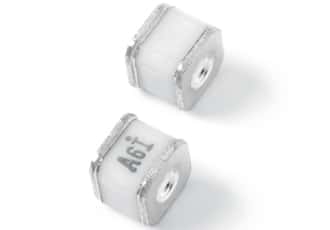source: Littelfuse news
Littelfuse has introduced what it claims to be the smallest (5.0×5.0×4.2mm) squared Gas Discharge Tube (GDT) with a 5kA surge capability and a ≤0.7pF off-state capacitance value available in the market today. The SH series GDT is designed to provide high levels of protection against fast-rising transients caused by lightning disturbances.
Its low off-state capacitance is compatible with high bandwidth applications and this capacitance loading value does not vary if the signal voltage across the GDT changes. It was specifically designed for protection of electrical, multimedia, and communication equipment against overvoltage transients.
Typical applications for SH series Gas Discharge Tubes include G.fast, xDSL, 10GbE, and 10/100/1000 Base-T Ethernet port protection for the telecom/datacom market; coaxial cable protection in satellite, CATV equipment and set top boxes for consumer products; industrial automation interfaces such as Ethernet, RS-485 and RS-232, for the industrial market; and AC power line protection in power inverter/Variable Frequency Drives (VFDs) for the renewable energy market.
“The SH Series GDT is an ideal solution because it can meet today’s high surge rating requirements while maintaining compatibility with high speed, wide bandwidth applications,” said Stephen Li, Global Product Manager, Gas Discharge Tubes at Littelfuse. “In addition to protecting electrical, multimedia, and communication equipment against overvoltage transients, it also simplifies the SMT pick and place assembly process due to its square body and terminals.”
Key features:
- High surge withstand capability in a miniature package makes them suitable for high surge, high density layout applications such as radio base station power and cable modems.
- Low off-state capacitance (≤0.7pF) minimises insertion loss. Also, this value does not vary as the signal voltage varies, so it does not demodulate the signal of interest. These features make it compatible with high speed, wide bandwidth applications such as G.fast, xDSL equipment, and cable modems.
- The square body and terminals of the SH Series make the pick and place process simpler during automated PCB manufacturing, compared to cylindrical body GDTs.































